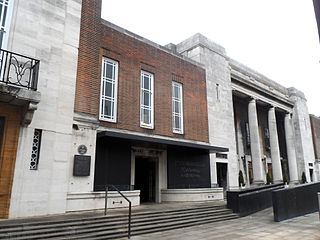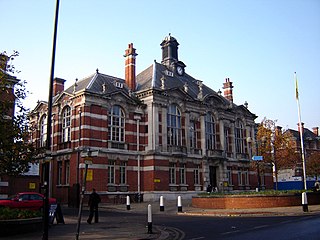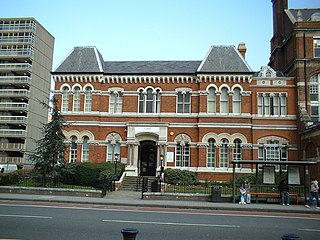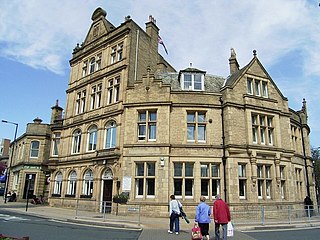
Catford is a district in south east London, England, and the administrative centre of the London Borough of Lewisham. It is southwest of Lewisham itself, mostly in the Rushey Green and Catford South wards. The population of Catford, including Bellingham, was 44,905 in 2011.

Lewisham is an area of southeast London, England, six miles south of Charing Cross. It is the principal area of the London Borough of Lewisham, and was within the historic county of Kent until 1889. It is identified in the London Plan as one of 35 major centres in Greater London, with a large shopping centre and street market. Lewisham had a population of 60,573 in 2011.

In local government, a city hall, town hall, civic centre, guildhall, or municipal building is the chief administrative building of a city, town, or other municipality. It usually houses the city or town council, its associated departments, and their employees. It also usually functions as the base of the mayor of a city, town, borough, county or shire, and of the executive arm of the municipality.

William Henry Hugo Newman-Norton is a British independent Oriental Orthodox bishop. He is the Patriarch of Glastonbury and head of the British Orthodox Church (BOC) with the title of British Patriarch and is known as Abba Seraphim.

The Broadway Theatre is a theatre on Rushey Green, Catford, in the London Borough of Lewisham. A grade II listed building, the theatre was built in 1932 and is an example of Art Deco design. It has two auditoriums, an 800-seat main theatre and a small 80-seat studio theatre. The theatre's programme consists of a diverse mix of theatre and music, including stand up comedy, nostalgia shows, pantomime, drama and children's theatre.

Camden Town Hall, known as St Pancras Town Hall until 1965, is the meeting place of Camden London Borough Council. The main entrance is in Judd Street with its northern elevation extending along Euston Road, opposite the main front of St Pancras railway station. It was completed in 1937 and has been Grade II listed since 1996.

Islington Town Hall is a municipal facility in Upper Street, Islington, London. The town hall, which is the headquarters for Islington London Borough Council, is a Grade II listed building.

Lewisham London Borough Council, also known as Lewisham Council, is the local authority for the London Borough of Lewisham in Greater London, England. It is a London borough council, one of 32 in London. The council has been under Labour majority control since 2010. It has been led by a directly elected mayor since 2002. The council meets at Lewisham Town Hall in the Catford area of the borough.
The bombing of Sandhurst Road School occurred during an air raid on Wednesday, 20 January 1943 when the school on Ardgowan Road, Catford, south east London was seriously damaged. A German fighter-bomber dropped a single 500-kilogram (1,100 lb) bomb on the school at 12:30 pm, killing 38 children and 6 staff and injuring another 60 people. Many were buried for hours under the rubble.

Battersea Town Hall, originally the New Parochial Offices, Battersea, is a Grade II* listed municipal building in Battersea, south London, designed by Edward Mountford and erected between 1891 and 1893 by the Battersea vestry to provide public halls and office space for its staff. The building served for 72 years as the hub of municipal Battersea until the centre of local government was moved to neighbouring Wandsworth in 1965, after which it transitioned to use as a community and arts centre, latterly known as the Battersea Arts Centre.

The Old Town Hall, Richmond on Whittaker Avenue in Richmond, London is a former municipal building which from 1893 to 1965 served as the town hall for the Municipal Borough of Richmond.

Hackney Town Hall is a municipal building in Hackney, London. The town hall, which is the headquarters of Hackney London Borough Council, is a Grade II listed building.

Stoke Newington Town Hall is a municipal building in Church Street, Stoke Newington, London. It is a Grade II listed building.

Tottenham Town Hall is a municipal building in Town Hall Approach Road, Tottenham, London. It is a Grade II listed building.

Stratford Town Hall is a municipal building in Stratford, London. It is a Grade II listed building.

Walworth Town Hall is a municipal building in Walworth Road, Southwark, London. It is a Grade II listed building. It was built for the vestry of the parish of Newington, opening as the Newington Vestry Hall in 1865. When Newington became part of the Metropolitan Borough of Southwark in 1900 the building served as Southwark Town Hall. It ceased to be a headquarters of local government in 1965 when the London Borough of Southwark was created.

Bermondsey Town Hall is a municipal building in Spa Road, Bermondsey, London. It is a Grade II listed building.

St George's Town Hall, formerly known as Stepney Town Hall, and, before that, St George's Vestry Hall, is a municipal building on Cable Street, Stepney, London. It is a Grade II listed building.

Wandsworth Town Hall is a municipal building on the corner of Wandsworth High Street and Fairfield Street in Wandsworth, London. The building, which is the headquarters of Wandsworth London Borough Council, is a Grade II listed building.

Keighley Town Hall is an early 20th century municipal building in Keighley, West Yorkshire, England. It is a Grade II listed building.
























